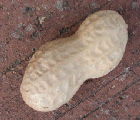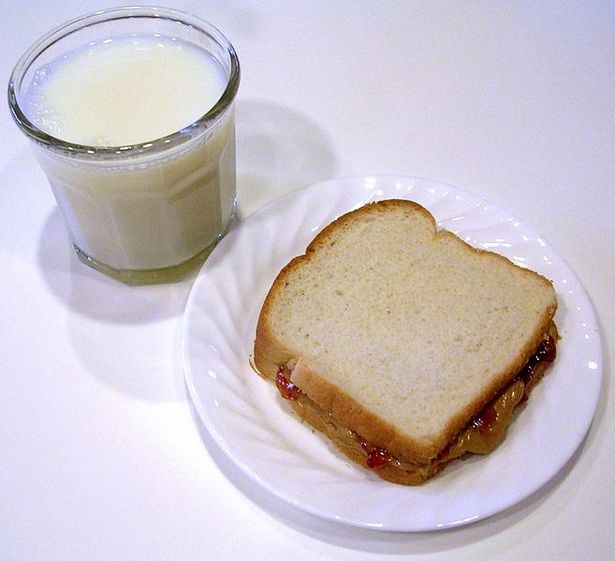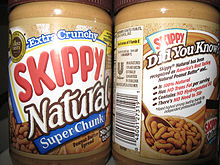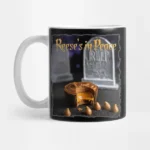PB&J: Every American Kid’s Favorite Sandwich
The peanut is thought to have originated in Brazil and Central America, making its way to Africa by means of Spanish explorers and traders. When African slaves were brought to United States, the peanut arrived with them. In fact, the name "goober," as they are called in the southern states, comes directly from the African word "nguba."
 Peanuts were first grown commercially in the early 1800s in North Carolina and Virginia, but the first notable consumption didn't occur until the outbreak of the Civil War where they were used as food by soldiers on both sides. By the last half of the century, peanuts were a popular snack sold by street vendors, at baseball games, and circuses.
Peanuts were first grown commercially in the early 1800s in North Carolina and Virginia, but the first notable consumption didn't occur until the outbreak of the Civil War where they were used as food by soldiers on both sides. By the last half of the century, peanuts were a popular snack sold by street vendors, at baseball games, and circuses.
Contrary to what some believe, it was not George Washington Carver that invented peanut butter. While Dr. Carver discovered more than three hundred uses for this popular legume, the precursor to peanut butter as we know it today got its beginning in 1884 when Marcellus Gilmore Edson of Canada was issued a patent for the finished product of his method of milling roasted peanuts.
At first, peanut butter was hand made by some physicians as an alternative high protein food for geriatric patients with bad or no teeth. In 1895, Dr. John Harvey Kellogg (of the Kellogg cereal fame) patented his own method of creating peanut butter using steamed nuts, which he served to patients of his Battle Creek Sanitarium. The next year, Joseph Lambert, an employee of Dr. Kellogg, began making and selling a hand-operated peanut grinder to housewives who wanted to make peanut butter for their own families. Three years later his wife, Almeeta, published The Complete Guide to Nut Cookery, America's first nut cookbook.
Then in 1903, Dr. Ambrose Straub of St. Louis patented a peanut butter-making machine. Later that year, Bayle Food Products bought the commercial rights to Dr. Straub's process and in 1904 introduced their new product to visitors of the St. Louis World Fair. Selling samples for one penny each, Bayle Foods sold out in just three days earning $705 and put them on the path to becoming Americas first peanut butter vendor. Soon peanut butter was available at grocers all across the country.
 The first known reference to the traditional peanut butter and jelly sandwich was published in an article by Julia Davis Chandler in the Boston Cooking School of Culinary Science and Domestic Economics in 1901. At that time, peanut butter was considered a delicacy enjoyed by aristocrats in America's finest tearooms and upscale affairs in some rather exotic ways--peanut butter and watercress; peanut butter and pimento; peanut butter spiced with paprika and Worcestershire sauce.
The first known reference to the traditional peanut butter and jelly sandwich was published in an article by Julia Davis Chandler in the Boston Cooking School of Culinary Science and Domestic Economics in 1901. At that time, peanut butter was considered a delicacy enjoyed by aristocrats in America's finest tearooms and upscale affairs in some rather exotic ways--peanut butter and watercress; peanut butter and pimento; peanut butter spiced with paprika and Worcestershire sauce.
By 1914 there were a number of companies making peanut butter, including Krema Products Company in Columbus, Ohio, the oldest peanut butter company still in operation today.
With the continued commercialization of the peanut butter industry came a sweeter, creamier product at a price that made it affordable to just about everyone. This, along with the invention of sliced bread by the 1920s, provided children the ability to make peanut butter sandwiches themselves. Originally peanut butter sandwiches were extremely adventuresome, as evidenced by the following sampling of recipes from Florence A. Cowles' 1928 book, Seven Hundred Sandwiches:
Peanut and Pimento Sandwich
Peanut and Celery Sandwich
Peanut Butter and Cabbage Sandwich
Peanut Butter and Orange Sandwich (orange juice and peel)
Peanut Butter amd Marshmallow Sandwich
Peanutpine Sandwich (peanut butter, honey, walnuts, lettuce, pineapple)
Peanut Butter and Ham Sandwich
Peanut Butter and Tomato Sandwich
Peanut Butter and Pickle Sandwich
Pimcel Sandwich (celery, pimento, salad dressing, salt, and paprika)
Peanut Butter and Ginger Sandwich
Egg and Peanut Butter Sandwich
Dixieland Sandwich (roasted peanuts, fried bacon, pimentos, and salad dressing)
Peanut and Lettuce Sandwich
Southern Sandwich (tomatoes, mayonnaise, and salted peanuts on whole wheat)
Peanut Butter and Olive Sandwich (with mayo on white or rye)
There were also several sandwiches made with peanut butter and fruits ranging from apples, raisins, and prunes to bananas and cherries. There were peanut butter sandwiches with honey and maple syrup and, of course, various jams.
Despite its popularity, early peanut butters had freshness problems. Since peanut oil has an extremely low melting point, peanut butter kept at room temperature would separate, oxidize and turn rancid. Also, salt added to the product to enhance flavor would separate and crystallize. Therefore, peanut butter, which was sold to grocers in tubs, had to be stirred frequently to prevent the problem.
 During the 1920s, Joseph L. Rosefield, a food businessman and industry innovator, began experimenting with ways of preventing oil separation and spoilage. He found that replacing eighteen percent of the product's natural oil with hydrogenated oil allowed for a thicker, more creamy peanut butter that didn't separate. It also did not stick to the roof of the mouth as badly as previous products. By 1932, he introduced "Skippy" brand peanut butter, named after a children's comic strip. Three years later, his company came out with the first wide-mouth peanut butter jar, which too became a standard with the industry.
During the 1920s, Joseph L. Rosefield, a food businessman and industry innovator, began experimenting with ways of preventing oil separation and spoilage. He found that replacing eighteen percent of the product's natural oil with hydrogenated oil allowed for a thicker, more creamy peanut butter that didn't separate. It also did not stick to the roof of the mouth as badly as previous products. By 1932, he introduced "Skippy" brand peanut butter, named after a children's comic strip. Three years later, his company came out with the first wide-mouth peanut butter jar, which too became a standard with the industry.
During World War II, peanut butter and jelly were part of U.S. soldiers' rations. On the homefront, food rationing was commonplace during the War with meats and dairy products scarce and expensive. Peanut butter on the other hand was a cheap, readily available source of protein, just as during the Great Depression of the 1930s.
Not only has the salty-sweet flavor of peanut butter and jelly sandwiches become a mainstay of the American diet for the past sixty years, for many people, its preparation has become a sacred ritual--the kind of bread, jelly, or jam that is used (grape is the number one choice), even the way it is cut (40% diagonal, 31% horizontal). Twenty-five percent don't cut their sandwich as all, and another one in four have to have the crust removed.
Any way you slice it, the average child in America will consume 1,500 peanut butter and jelly sandwiches before he or she graduates high school making it America's most popular children's sandwich.
Find Em: Peanut Butter & Company, New York, New York; Peanut Butter Bar, Los Angeles, California; The PB&J Shop, Louisville, Kentucky
Make Em: The Elvis PB & J, Krispy Kreme Bacon Peanut Butter & Jelly Sandwich, Peanut Butter & Jelly Flautas


